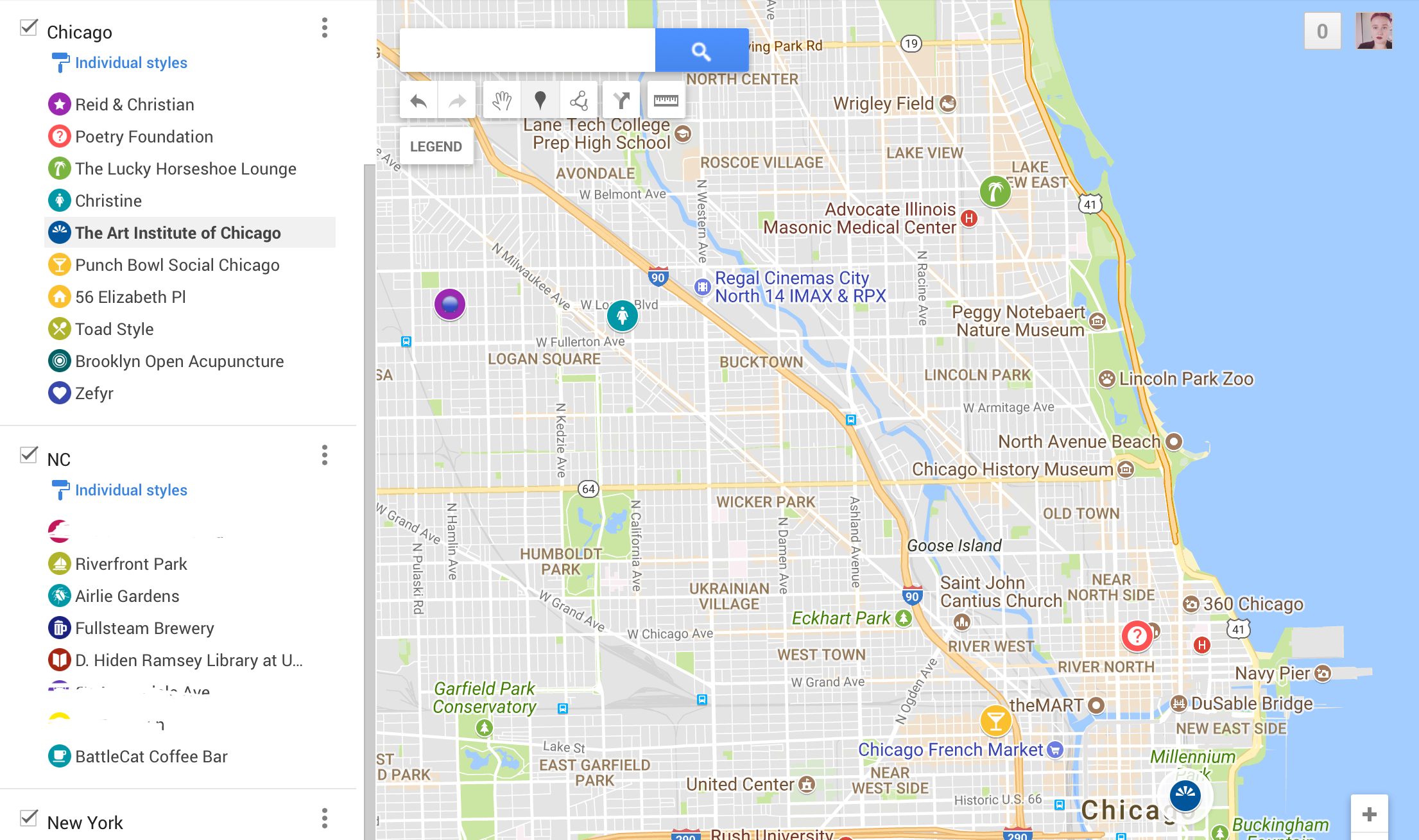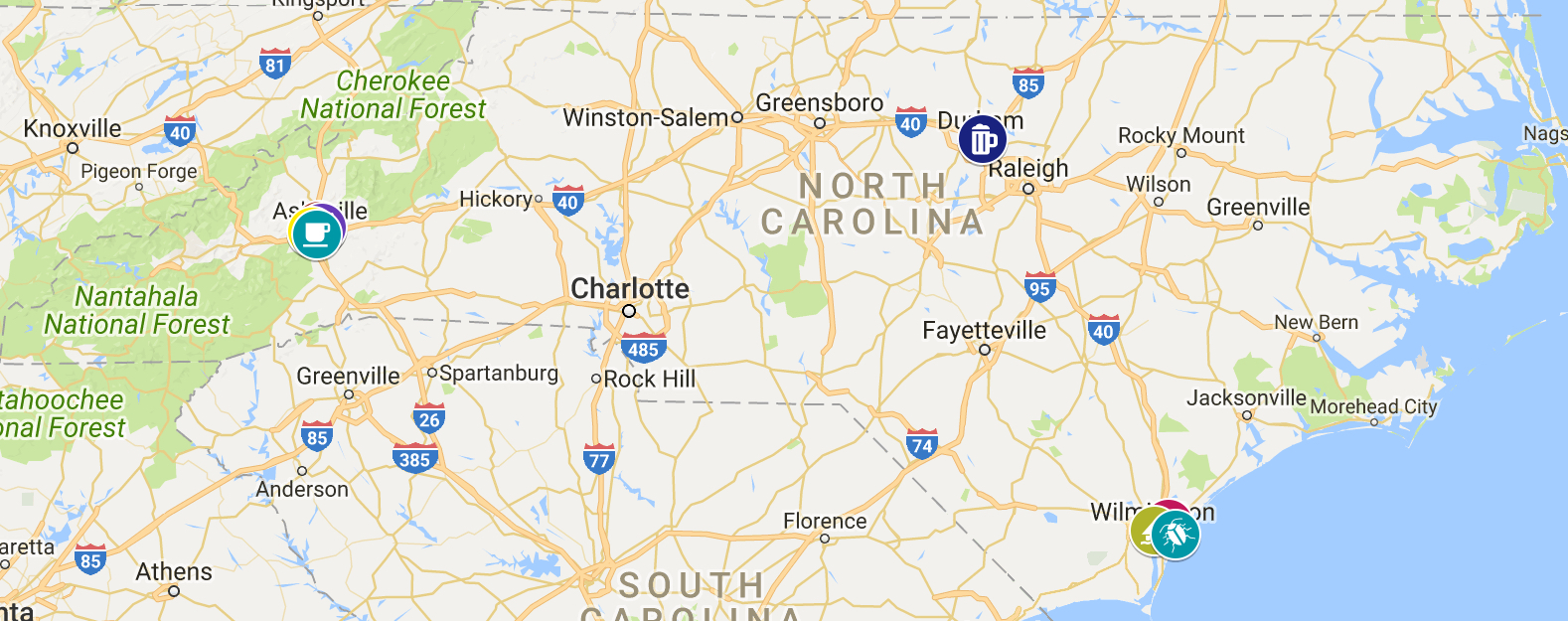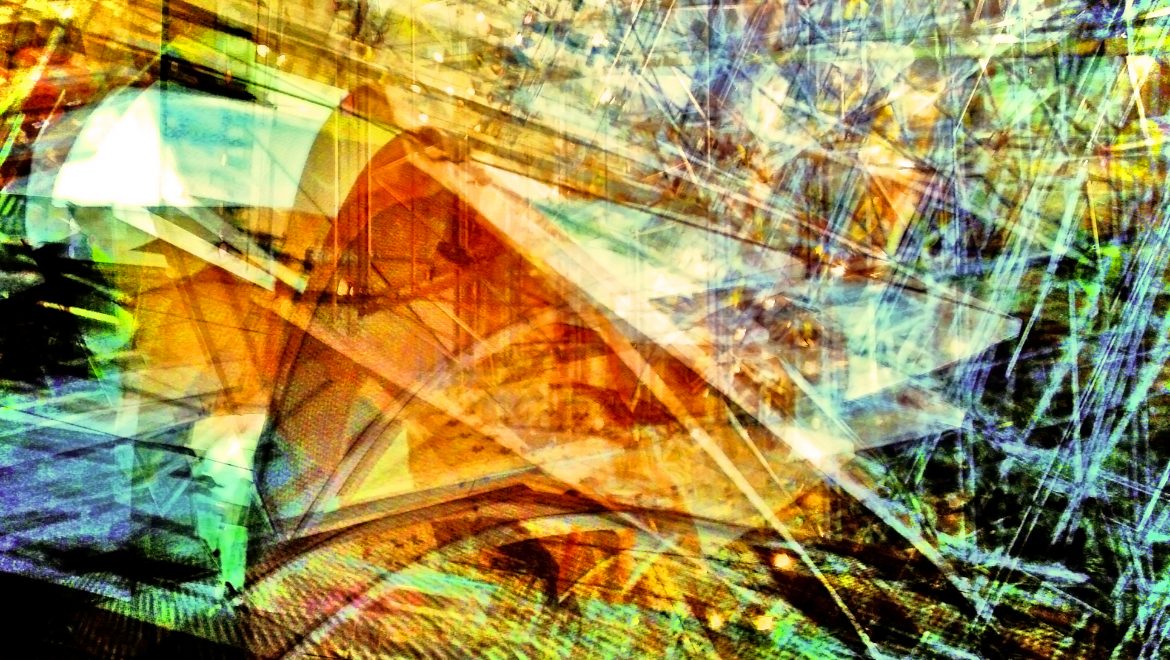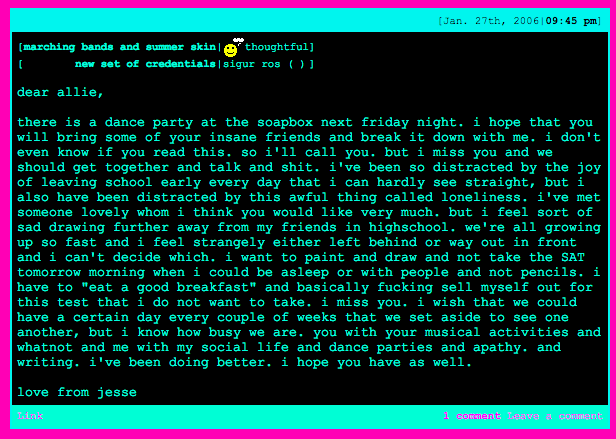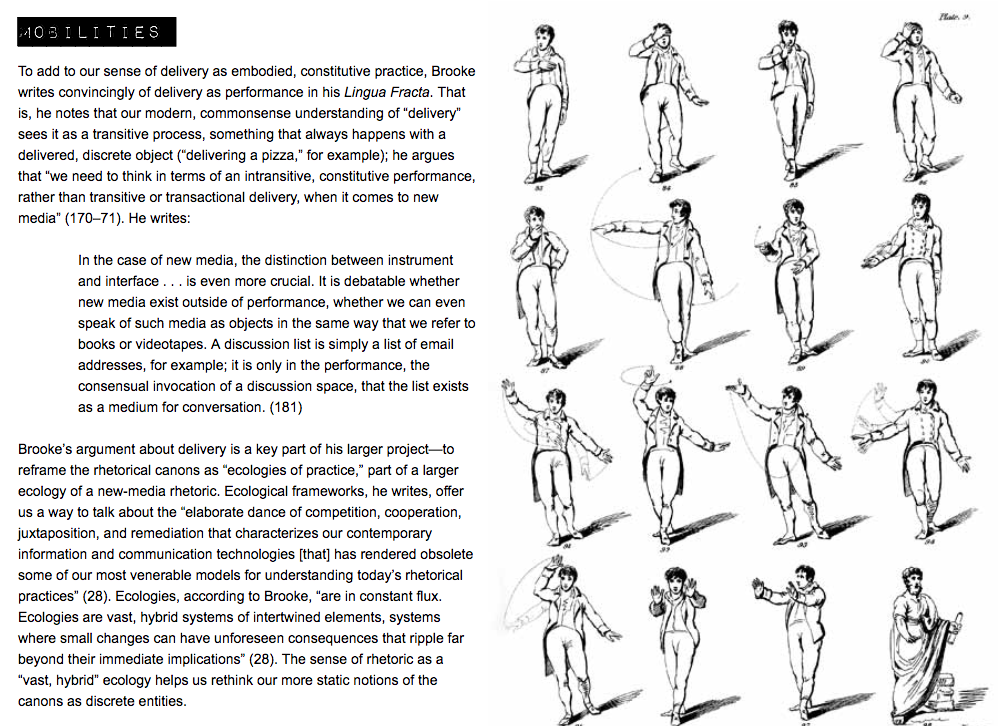Alexander, Jonathan and Jacqueline Rhodes. On Multimodality: New Media in Composition
Studies. USA: Conference on College Composition and Communication of the National
Council of Teachers of English, 2014. Print.
Situationism is the avant-garde continental movement in the mid 20th century that centered reclamatory aesthetics through a proto-queer reimagining of culture. Rhodes and Alexander want us (researchers, instructors, etc) to détourne by creating our own multimodal texts, which they themselves have done in various “professional” spaces throughout their careers. The authors are adamant that instructors must explore our own spectacular technai, our selves, and digital rhetorics in tandem. Alexander and Rhodes spend time advocating “for the power of images and mashups to create rhetorical possibilities that… question standard narratives” (Rhodes and Alexander 109); in brief, remix is totally queer.
#WeirdTwitter does its own version of détournement: using public digital space for surrealist purposes, undercutting the networking value of social media, of a public digital persona, instead implementing another Situationist technique of dérive, or what Guy Debord described as “a mode of experimental behavior linked to the conditions of urban society: a technique of rapid passage through varied ambiances,” to subvert the intended purpose of Twitter by using its constraints to make something that challenges normativity, that queers dominant narrative.
By problematizing the status quo, #WeirdTwitter has established itself as a markedly queer space in the digital sphere; though many active #WT users are anonymous, many public figures that have been influenced by the rhetoric of #WT are queer, gender non-conforming, trans, or otherwise implementing a queering of dominant discourse by their embodied identities. While Twitter is a disembodied space, the enactment of queer détournement ties these reimaginings to an embodied, and othered, identity; #WeirdTwitter is thereby expansive and autonomous. Opportunities exist on #WT and other digital platforms for re-inscribing embodied identities.
Bawarshi, Anis S. and Mary Jo Reiff. “Chapter 5: Genre in Rhetorical and Sociological
Traditions.” Genre: An Introduction to History, Theory, Research, and Pedagogy.
USA: Parlor Press and The WAC Clearinghouse, 2010. Web.
—.“Chapter 6: Rhetorical Genre Studies.” Genre: An Introduction to History, Theory,
Research, and Pedagogy. USA: Parlor Press and The WAC Clearinghouse, 2010. Web.
—. “Chapter 7: Genre Research in Academic Contexts.” Genre: An Introduction to History,
Theory, Research, and Pedagogy. USA: Parlor Press and The WAC Clearinghouse, 2010.
Web.
Bazerman, Charles. “Textual Performance: Where the Action at a Distance Is.” Journal of
Rhetoric, Culture, and Politics 23.2 (2003): 379-396. Web.
Bitzer, Lloyd. “The Rhetorical Situation.” Philosophy & Rhetoric 25, Selections from Vol. 1
(1992): 1-14. Web.
The “rhetorical situation as a natural context of persons, events, objects, relations, and an exigence which strongly invites utterance” (4); Bitzer views participation as a crucial form of social engagement, as rhetoric occurs within a cultural moment; genre is inextricably tied to social situation, and, in fact, cannot exist without a generic situation in which to engage (3). “[A] work of rhetoric is pragmatic; it comes into existence for the sake of something beyond itself; it functions ultimately to produce action or a change in the world; it performs some task” (emphasis mine, 3).
- exigence → “an imperfection marked by urgency” (6)
- audience → “those persons who are capable of being influenced by discourse” (7)
- constraints → influences which “have the power to constrain decision and action” (emphases mine, 8)
Applying Bitzer’s theory to #WeirdTwitter, as I have worked towards in the past, presented new and complicated views on digital genre: while the presence of constraint is obvious (140/280 characters), how do we determine audience? Exigence too is in flux, dependent upon the site of discourse; the imperfection here is perhaps Twitter’s intention: to foment “networking” in a professional/managerial context. #WT’s largely anti-authoritarian ideology presents challenges to digital branding and identity management, and Bitzer’s “urgency” may point us to DIY digital culture or to any unchecked capitalist ideology in digital space. Connecting these to embodiment theory means that I have to define Bitzer’s “constraints” as embodied as well: what kinds of rhetorical agency are available to non-hegemonic/abled bodies? How do these bodies impact the kinds of rhetorics they perform, and where they perform them?
Blackmore, Susan. The Meme Machine. Oxford University Press, 1999.
boyd, danah. It’s Complicated: The Social Lives of Networked Teens. USA: Yale University
Press, 2014. Print.
Brim, Matt. “Queer Pedagogical Desire: A Study Guide.” Women’s Studies Quarterly 41.3-4
(2013): 173-189. Web.
Brooke, Collin Gifford. Lingua Fracta: Towards a Rhetoric of New Media. Hampton Press, 2009. Print.
Carr, Diane. “Constructing disability in online worlds: conceptualising disability in online research.” London Review of Education 8.1 March 2010. 51-61.
Davis, Lennard J. Bending Over Backwards: Disability, Dismodernism, and Other Difficult Positions. NYU Press, 2002. Print.
Devitt, Amy. “Generalizing About Genre: New Conceptions of an Old Concept.” College
Composition and Communication 44.4 (1993): 573-586. Web.
Devitt’s “Generalizing About Genre: New Conceptions of an Old Concept” is an influential 1993 article on new approaches within genre studies to respond to contemporary (maybe even digital?) demands. Genre is a “dynamic and… essentially semiotic social construct,” which positions genre as a crucial feature of digital writing, especially online spaces that we can consider public (Devitt 573).
Devitt articulates a shift from form (classification) to context (cultural artifact/subject) (573); and further, a shift from product to process, alluding to Bakhtin (Devitt 574). Genre when viewed as static codes product as the value; thus, rejection of culturally-coded forms (genres) can be read as “individual genius” instead of incorrect (574). This issue still holds powerful sway over literary studies wherein genius is counter-cultural, anti-authoritarian, but still participating in “generic” spaces. Literary scholars treat authors and texts as objects of study, and the more an author fits into Devitt’s “genius” paradigm, the more provocative attention can be paid to these masculine modes of knowledge as static, intractable, objective. While other disciplines are similarly preoccupied by coding text categorically, Devitt’s example of literature posits that this implicit inscription of texts as stagnated objects (of study), eliminates the notion that texts are instead evolving cultural/communicative artifacts (574).
“Genres develop…because they respond appropriately to situations that writers encounter repeatedly” (Devitt 576); widespread hand-wringing at the dearth of writing and reading in contemporary culture fails to account for widespread technological literacy and communication in digital spaces. (danah boyd’s influential longitudinal study of youth engagement with technology reveals how the locus of writing/rhetoric has shifted to multimodal digital platforms.) According to Devitt, as digital rhetoric has gained influence across culture, genre has accommodated to the constraints of digital spaces in a collaborative “co-construction” of text and context (Bawarshi).
Devitt also articulates how genre is culturally-specific; notions of “appropriateness” in variable communicative contexts differentiate based on cultural codes and mores. In essence, genre is both influential upon and shaped by cultural norms; writers “read” rhetorical situations and manipulate/re-interpolate genres to “respond appropriately” (577). In this sense, genre “not only responds to but also constructs recurring situation” (577). The exigence here is, simply, communication.
Semiotic and social means that identity plays an integral role in Devitt’s—and my—conception of genre. Tracing back to Goffman, we can understand identity as a performance of the self, a series of deliberately-made choices that articulate the “inner” self and translate it to an outward—or social—space. For my purposes, these spaces are digital, or inherently stripped of embodiment in more structuralist, physical terms. Instead, individual rhetors make choices about the texts that they create within these digital spaces: alphabetic, visual, aural, etc. These cues coalesce in an intentional re-embodied collection of semiotic moments, or signs, that offer up information about the user themselves. This actually offers expansions on the forms of embodiment that folks can take in the material world: closeted queer and trans people construct simulacra of themselves as fully out; disabled and chronically ill people can access spaces that institutional inaccessibility excludes them from; academics can attend conferences, listen to lectures, and teach online.
Haraway, Donna. “A Cyborg Manifesto: Science, Technology, and Socialist-Feminism in the Late Twentieth Century.” Simians, Cyborgs and Women: The Reinvention of Nature. Routledge, 1991. 149-181.
—. Modest_Witness@Second_Millennium.FemaleMan_Meets_OncoMouse™: Feminism and
Technoscience. Routledge, 1997. Print.
Hayles, N. Katherine. How We Became Posthuman: Virtual Bodies in Cybernetics, Literature,
and Informatics. University of Chicago Press, 1999. Print.
Herrman, John and Katie Notopoulos. “Weird Twitter: The Oral History” Buzzfeed. Buzzfeed,
Inc. 5 April 2013. Web.
King, Tiffany Lethabo. “Humans Involved:Lurking in the Lines of Posthumanist Flight.” Critical
Ethnic Studies 3.1 (Spring 2017): 162-185.
King here presents a critique of posthumanism as a facet of existing axes of oppression. Is posthuman really just seeking distance from the othered nonhuman? If posthumanism desires to fragment the liberal subject, what if the marginalized subject, the embodied subject subjected to violence and oppression in the forms of settler colonialism, ghettoization—both geographic and intellectual—and architectures of oppression.
By the term architecture here, I mean the systemic infrastructural conception of the human: the architecture of rhetoric, then, reifies and reinforces these ghettos to which the marginalized subject is confined.
Rhetoric here functions to further strip the work of radical subjectivities by defining them still as in the margins: “minority” language is deployed as code for unlike us, unlike the human.
The further a subject moves from this whole idealized Kantian subject, the closer they move towards the margins, which encircle and ensnare. This marginal architecture includes the ineffectual nonprofit industrial complex, privatized medicine, the university: all well-oiled gatekeepers who welcome assimilated subjects while maintaining a closed-border policy to subjects unwilling—or unable—to pimp their own trauma for access to resources. Thus the snare of neoliberalism appears again: the uncooperative individual is to blame for their own struggle to survive.
DH work often invokes this posthumanist rhetoric, as if technologies’ emergence has somehow dismantled subjectivity, and if these technologies are not imbued with the ideologies of their creators, e.g. Apple’s facial recognition technology unable to recognize Black faces.
Micciche, Laura R. “Feminist Pedagogies.” A Guide to Composition Pedagogies. Eds. Gary Tate,
Amy Rupiper Taggart, Kurt Schick, and H. Brooke Hessler. New York: Oxford University Press, 2014. 128-145. Print.
Miller, Carolyn R. “Genre as Social Action.” Genre and the New Rhetoric. Eds Aviva Freedman
and Peter Medway. Bristol, PA: Taylor & Francis Ltd., 1994. Print.
Carolyn Miller’s article “Genre as Social Action” lays the groundwork for the continued emergence of rhetorical genre studies as a scholarly force inside of composition and rhetoric. In it, she positions genres as “forms of social action… [that] enable their users to carry out situated symbolic actions…[and] to perform social actions and relations, enact social roles, and frame social realities” (58-59). This interplay between rhetor and rhetorical (social) situation is central, Miller argues, to “how genres, through their use, dynamically maintain, reveal tensions within, and help reproduce social practices and realities” (59).
This semiotic relationship between genre and culture has been addressed by Bazerman, Bitzer, Bawarshi, and Devitt, to name a few, but Miller’s firm grasp on genre as ontological and contextual renders this article a classic: context dictates “communicative purpose(s), discourse community membership, genre nomenclature, or even genre chains and occluded genres”(59).
Miller also articulates that communication must be “viewed as an ongoing, intersubjective performance, one that is mediated by genres and other culturally available tools” (59). I have long considered what Miller means by this “intersubjective performance,” and have previously connected this term to my research on Weird Twitter as a rhetorical situation that provides abundant insight into online discourse communities: e.g., How do individuals convey identity and voice through manipulation of genre to address the rhetorical situation of their own construction (considering private/anonymous/dis-identified users) (what about bots?)?
In brief, Miller, and rhetorical genre studies more generally, wants to know more about “the role that genres play in how individuals experience, co-construct, and enact social practices and sites of activity” (59). This “co-construction” is central to my connection between embodied offline subjectivity and dis-/re-embodied online identity: what groupings of cultural signs can/do users enact to convey identity markers that hold value to them online?
—. “Rhetorical Community: The Cultural Focus of Genre.” Genre and the New Rhetoric. Eds
Aviva Freedman and Peter Medway. Bristol, PA: Taylor & Francis Ltd., 1994. Print.
Milner, Ryan M. The World Made Meme: Public Conversations and Participatory Media. The MIT Press, 2016. Print.
McRuer, Robert. “Composing Bodies; or, De-Composition: Queer Theory, Disability Studies,
and Alternative Corporealities.” Journal of Rhetoric, Culture, and Politics 24.1 (2004):
47-78. Web.
McRuer posits that composing itself (as a practice) is messy and dis-composed; he then advocates for connecting the agitation of the composing, laboring body into composition classrooms (49) and even claims that enforcing “programmatic” and compulsory performance of rote forms and docile bodies (51) in composition classrooms, we are serving capitalist interests. This service strips composition of any radical political possibilities, and composing’s innate connection to embodiment renders this disconnect highly problematic. For McRuer, it is in composition that we have a political obligation to challenge hegemonic identities and narratives; there is an opportunity for embodiment to be taken seriously, and McRuer holds that engaging student writers in moments of otherness, what he terms “queer/disabled moments,” opens possibilities of resistance. He further advocates for queering or “cripping” texts, challenging essentialist ideologies within cultural artifacts (59), invoking Sedgwick to explicate his use of “queer” as a verb: “‘the open mesh of possibilities, gaps, overlaps, dissonances and resonances… [that] aren’t made (or can’t be made) to signify monolithically’” (57). This anti-capitalist perspective on pedagogy is a valuable method for bridging theories on embodiment and composition, and it’s my intention to connect these to hybrid teaching and digital spaces as well.
Murray, Janet H. Hamlet on the Holodeck: The Future of Narrative in Cyberspace, updated
edition. The MIT Press, 2017.
Paperson, La. A Third University is Possible. University of Minnesota Press, 2017.
Pearson, Erika. “All the World Wide Web’s a stage: The performance of identity in online social networks.” First Monday 14.3 March 2, 2009. Web.
Price, Margaret. Mad at School: Rhetorics of Mental Disability and Academic Life. The University of Michigan Press, 2011.
Scarry, Elaine. The Body in Pain: The Making and Unmaking of the World. Oxford University Press, 1985.
Schryer, Catherine F. “Genre Time/Space: Chronotopic Strategies in the Experimental Article.”
JAC: A Journal of Rhetoric, Culture, and Politics 19.1 (1999): 81-89. Web.
Selfe, Cynthia L. Technology and Literacy in the Twenty-First Century: The Importance of
Paying Attention. Southern Illinois University Press: Studies in Writing and Rhetoric series, 1999. Print.
Tuck, Eve. “Breaking up with Deleuze: desire and valuing the irreconcilable.” International
Journal of Qualitative Studies in Education 23.5, Sept-Oct 2010, 635-650. Web.
Tuck implements the extended metaphor of the dissolution of a romantic relationship to articulate her historical relationship to Gilles Deleuze; while she ultimately embraces several Deleuzian concepts in her own work, she carefully explicates the limitations of his theories, many of which she feels are incomplete/undertheorized. Tuck, a GC graduate from Urban Education and a prominent young scholar in decolonial theory and critical ethnic studies, masterfully organizes this article to critique the one-dimensionality of much of continental philosophy, instead pilfering a few choice theories and essentially tossing the rest. This reverse-colonizing of some central poststructuralist theorists and texts is not incidental: Tuck is committed to liberatory methodologies and makes use of them in this piece. Her methodological centering of desire is central to her approach, and she works to extract this desire from even the messiest of Deleuzian theory. Tuck’s work and ethics are delightful evidence of critical decolonial work happening today, and her consistency in centering radical subjectivities makes her work vital to my work surrounding embodiments online.
Wallace, David L. and Jonathan Alexander. “Queer Rhetorical Agency: Questioning Narratives
of Heteronormativity.” Journal of Rhetoric, Culture, and Politics 29.4 (2009): 793-819.
Web.
Wilson, James C. and Cynthia Lewiecki-Wilson, eds. Embodied Rhetorics: Disability in
Language and Culture. Southern Illinois University Press, 2001. Print.
Wolff, William I. “Baby, We Were Born to Tweet: Springsteen Fans, the Writing Practices of In Situ Tweeting, and the Research Possibilities for Twitter.” Kairos 19.3 (2013). Web.
Wood, Caitlin, ed. Criptiques. May Day Publishing, 2014.
Wynter, Sylvia. “‘No Humans Involved:’ An Open Letter to my Colleagues.” Forum N.H.I.
Knowledge for the 21st Century 1.1, Knowledge on Trial, Fall 1994. Print.
